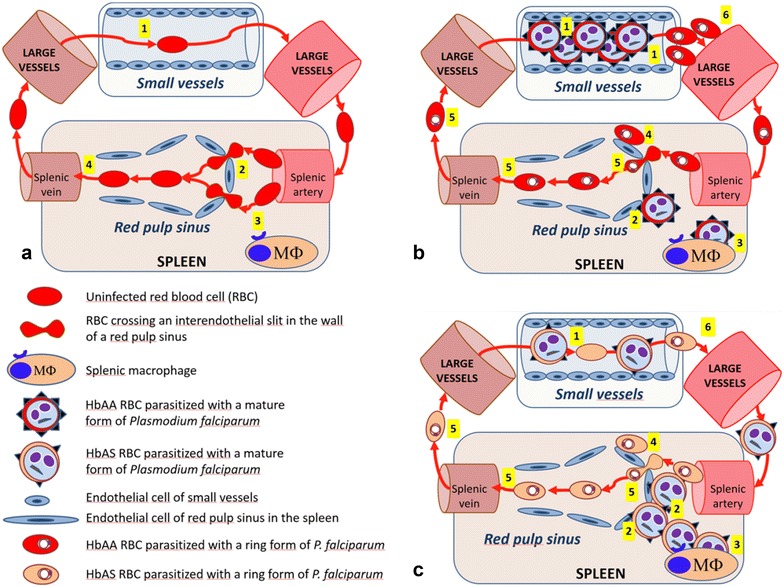Fig. 4.

Proposed model for sickle-cell trait-related protection from high Plasmodium falciparum parasitaemia and severe malaria. a The preserved deformability and normal surface of RBCs enable their efficient navigation through small vessels 1, crossing of narrow inter-endothelial slits (IES) in the wall of red pulp sinuses in the spleen 2, and escape from recognition by red pulp macrophages (MΦ) 3, resulting in rapid exiting from the spleen 4. b In HbAA patients, mature P. falciparum-infected RBCs express numerous PfEMP1 adhesins on their surface that mediate their accumulation in small vessels through adherence to endothelial cells 1. The few rigid mature forms that escape cytoadherence-based sequestration in small vessels cannot cross IES in the spleen 2, and are ultimately phagocytosed by splenic macrophages 3. While a proportion of RBCs infected with young ring forms is mechanically retained upstream from IES 4, most persist in circulation 5. The large population of RBCs infected with mature forms sequestered in small vessels 1 causes direct pathogenic effects leading to severe malaria and rapidly leads to high parasitaemia 6. c In HbAS patients, mature P. falciparum-infected RBCs express few PfEMP1 adhesins on their surface, resulting in a less-intense accumulation in small vessels 1. Those RBCs that escape cytoadherence-based sequestration in small vessels cannot cross IES in the spleen 2. This retention is expected to result in their phagocytosis by splenic macrophages 3. The small population of HbAS RBCs infected with mature forms sequestered in small vessels 1 give rise to only a small population of circulating ring-infected RBCs 6. HbAS patients may be protected from severe malaria by an amelioration of pathogenic effects due to a smaller biomass of infected RBCs sequestered in small vessels resulting from mechanical retention of non-adherent RBCs infected with mature forms in the spleen. This mechanism also explains lower parasitaemia and delayed time to a malaria episode
